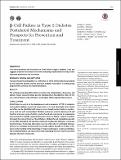| dc.contributor.author | Halban, Philippe A. | en_US |
| dc.contributor.author | Polonsky, Kenneth S. | en_US |
| dc.contributor.author | Bowden, Donald W. | en_US |
| dc.contributor.author | Hawkins, Meredith A. | en_US |
| dc.contributor.author | Ling, Charlotte | en_US |
| dc.contributor.author | Mather, Kieren J. | en_US |
| dc.contributor.author | Powers, Alvin C. | en_US |
| dc.contributor.author | Rhodes, Christopher J. | en_US |
| dc.contributor.author | Sussel, Lori | en_US |
| dc.contributor.author | Weir, Gordon C. | en_US |
| dc.date.accessioned | 2015-07-13T18:47:26Z | |
| dc.date.issued | 2014 | en_US |
| dc.identifier.citation | Halban, Philippe A., Kenneth S. Polonsky, Donald W. Bowden, Meredith A. Hawkins, Charlotte Ling, Kieren J. Mather, Alvin C. Powers, Christopher J. Rhodes, Lori Sussel, and Gordon C. Weir. 2014. “β-Cell Failure in Type 2 Diabetes: Postulated Mechanisms and Prospects for Prevention and Treatment.” Diabetes Care 37 (6): 1751-1758. doi:10.2337/dc14-0396. http://dx.doi.org/10.2337/dc14-0396. | en |
| dc.identifier.issn | 0149-5992 | en |
| dc.identifier.uri | http://nrs.harvard.edu/urn-3:HUL.InstRepos:17295713 | |
| dc.description.abstract | OBJECTIVE This article examines the foundation of β-cell failure in type 2 diabetes (T2D) and suggests areas for future research on the underlying mechanisms that may lead to improved prevention and treatment. RESEARCH DESIGN AND METHODS A group of experts participated in a conference on 14–16 October 2013 cosponsored by the Endocrine Society and the American Diabetes Association. A writing group prepared this summary and recommendations. RESULTS The writing group based this article on conference presentations, discussion, and debate. Topics covered include genetic predisposition, foundations of β-cell failure, natural history of β-cell failure, and impact of therapeutic interventions. CONCLUSIONS β-Cell failure is central to the development and progression of T2D. It antedates and predicts diabetes onset and progression, is in part genetically determined, and often can be identified with accuracy even though current tests are cumbersome and not well standardized. Multiple pathways underlie decreased β-cell function and mass, some of which may be shared and may also be a consequence of processes that initially caused dysfunction. Goals for future research include to 1) impact the natural history of β-cell failure; 2) identify and characterize genetic loci for T2D; 3) target β-cell signaling, metabolic, and genetic pathways to improve function/mass; 4) develop alternative sources of β-cells for cell-based therapy; 5) focus on metabolic environment to provide indirect benefit to β-cells; 6) improve understanding of the physiology of responses to bypass surgery; and 7) identify circulating factors and neuronal circuits underlying the axis of communication between the brain and β-cells. | en |
| dc.language.iso | en_US | en |
| dc.publisher | American Diabetes Association | en |
| dc.relation.isversionof | doi:10.2337/dc14-0396 | en |
| dc.relation.hasversion | http://www.ncbi.nlm.nih.gov/pmc/articles/PMC4179518/pdf/ | en |
| dash.license | LAA | en_US |
| dc.title | β-Cell Failure in Type 2 Diabetes: Postulated Mechanisms and Prospects for Prevention and Treatment | en |
| dc.type | Journal Article | en_US |
| dc.description.version | Version of Record | en |
| dc.relation.journal | Diabetes Care | en |
| dash.depositing.author | Weir, Gordon C. | en_US |
| dc.date.available | 2015-07-13T18:47:26Z | |
| dc.identifier.doi | 10.2337/dc14-0396 | * |
| dash.contributor.affiliated | Weir, Gordon | |


